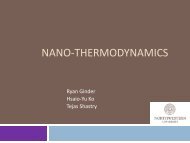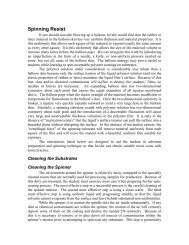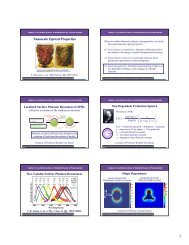A Practical Guide to SPM
A Practical Guide to SPM
A Practical Guide to SPM
You also want an ePaper? Increase the reach of your titles
YUMPU automatically turns print PDFs into web optimized ePapers that Google loves.
10<br />
Intermittent<br />
contact<br />
Contact<br />
Non-contact<br />
Figure 4-1. Attractive and repulsive forces.<br />
Repulsive force<br />
Distance<br />
(tip-<strong>to</strong>-sample separation)<br />
Attractive force<br />
Contact AFM<br />
In contact AFM, the tip is in perpetual contact with the sample. The tip<br />
is attached <strong>to</strong> the end of a cantilever with a low spring constant —<br />
lower than the effective spring constant of the force holding the a<strong>to</strong>ms<br />
of most solids <strong>to</strong>gether. As the scanner gently traces the tip across the<br />
sample (or the sample under the tip), the contact force causes the<br />
cantilever <strong>to</strong> bend <strong>to</strong> accommodate changes in <strong>to</strong>pography.<br />
At the right side of the curve in Figure 4-1, the tip and sample are<br />
separated. As the tip and the sample are gradually brought <strong>to</strong>gether,<br />
their a<strong>to</strong>ms begin <strong>to</strong> weakly attract each other. This attraction increases<br />
until the a<strong>to</strong>ms are so close <strong>to</strong>gether that their electron clouds begin <strong>to</strong><br />
repel each other. This electrostatic repulsion progressively weakens the<br />
attractive force as the separation continues <strong>to</strong> decrease. The <strong>to</strong>tal force<br />
goes through zero and finally becomes positive (repulsive).<br />
The slope of the curve is very steep in the repulsive regime. This force<br />
balances and surpasses almost any force that attempts <strong>to</strong> push the<br />
a<strong>to</strong>ms closer <strong>to</strong>gether. In AFM, this means that when the cantilever<br />
pushes the tip against the sample, the cantilever bends rather than<br />
forcing the tip a<strong>to</strong>ms closer <strong>to</strong> the sample a<strong>to</strong>ms. Even if you use a very<br />
stiff cantilever <strong>to</strong> exert large forces on the sample, the inter-a<strong>to</strong>mic<br />
separation between the tip and sample a<strong>to</strong>ms does not decrease<br />
much. Instead, the sample surface, or the tip, or both, are likely<br />
<strong>to</strong> deform.<br />
In addition <strong>to</strong> the repulsive force described above, two other forces<br />
are generally present during contact AFM imaging: a capillary force<br />
exerted by the thin liquid layer often present on the sample surface in<br />
an ambient (non-vacuum) environment (typically, this layer is mostly<br />
water), and the force exerted by the cantilever itself. The capillary<br />
force arises when water wicks its way around the tip, applying a<br />
strong attractive force that tends <strong>to</strong> hold the tip in contact with the<br />
surface. The magnitude of the capillary force, <strong>to</strong>o, depends upon the<br />
tip-sample separation. The force exerted by the cantilever is like the<br />
force of a compressed spring. The magnitude and sign (repulsive or<br />
attractive) of the cantilever force depends upon the deflection of the<br />
cantilever and upon its spring constant. These forces are revisited in<br />
the Non-imaging Modes chapter.<br />
As long as the tip is in contact with the sample, the capillary force<br />
should be constant because the distance between the tip and the<br />
sample is virtually incompressible. (We assume here that the water<br />
layer is homogeneous across the scanning area.) The variable force in<br />
contact AFM is then the force exerted by the cantilever.
















